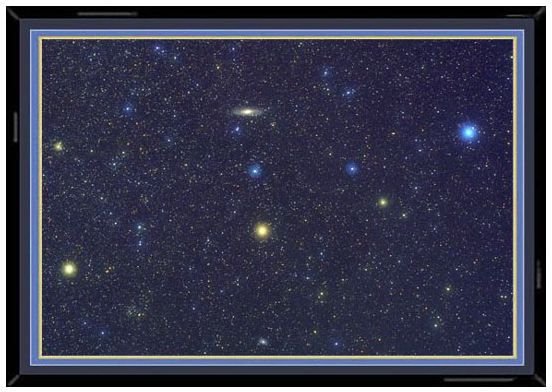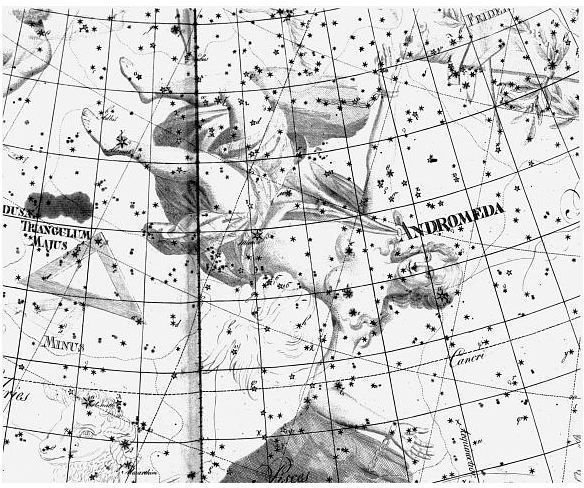History Behind the Constellation Andromeda & Other Facts on Andromeda Constellation Including Pictures
Andromeda the Constellation: Facts
1. Symbolism: Chained Maiden, Princess of Ethiopia
2. Right ascension: 1 hour
3. Declination: 40 degrees
4. Latitudes visible at: between 90 and -40 degrees
5. The best time to view: November 21:00 PM (9:00 PM)
6. Area of sky: 722 square degrees
7. Nearest star: Ross 248 (Ross 248 is 10.32 light years away)
8. Brightest star: Alpheratz (visual magnitude of 2.06)
9. Stars in the constellation: Alpheratz (Alpha Andromeda), Mirach (Beta Andromeda), Almach (Gamma 1 Andromeda), Adhil (Xi Andromeda)
10**. Other objects in the constellation:** The Andromeda galaxy (M31), the Triangulum galaxy (M33), M32 and M110 (both are satellite galaxies of the Andromeda galaxy).
11: Meteor showers: The Andromedids (some meteor shower activity is still seen in mid-November each year).
12. Mythology: In Greek mythology, Andromeda was the princess of Ethiopia. She was the daughter of Cepheus and Cassiopeia, rulers of Ethiopia. The Greek god of the sea, Poseidon, unleashed a sea monster (probably a Cetus) to teach the boastful Cassiopeia a lesson. The only way to stop the monster from destroying Ethiopia was to sacrifice Andromeda’s life. She was chained to the rock by the sea, but later rescued by Perseus. Perseus killed the monster and married Andromeda. Their child, Perses, was the ancestor of the Persian Kings. Andromeda is hailed as one of the most daring mythical heroines.
- History Behind the Constellation Andromeda: The Andromeda constellation is included in the ancient star catalogs of Ptolemy, Aratos of Soli and Eudoxos of Knidos. The M31 Andromeda galaxy is the most illustrious deep sky object in the Andromeda constellation. It is a spiral galaxy, just like the Milky Way. It was first observed by Al-Sufi in 964 AD. He described it as a “little cloud.” In 1612, it was observed through a telescope by Simon Marius. Early viewers, like Christiaan Huygens, considered the galaxy a hole in the heavens and never imagined it to be a star system. In the 1920s Edwin Hubble came to the conclusion that the galaxy was beyond the Milky Way when he identified the Cepheid variable stars in the constellation, using a 100-inch telescope at Mount Wilson.
[Image Top Right: Photo Credit: Torsten Bronger https://en.wikipedia.org/wiki/File:Andromeda_constellation_map.png]
Picture of Andromeda Constelation

[This photo of the constellation Andromeda shows, enlarged in their true color, the main “naked eye” stars that make up the shape of the constellation. Image courtesy of https://www.scienceandart.com_]_
More Fascinating Facts

The Constellation Andromeda is near to the celestial North Pole. People living in the southern hemisphere can rarely see the constellation, though it can sometimes be observed there during the spring.
The Andromedids meteor shower activity has faded away, but it did produce some awesome displays in the years 1872 and 1885, with several thousand meteors per hour.
The Andromeda constellation takes the rough shape of the English alphabet letter “A.”
The Andromeda galaxy can be seen with the naked eye, but only in non-lightpolluted cities. With the naked eye, it appears to be a fuzzy blob.
The Almach (or Gamma 1 And) has vibrant contrasting colors. The Mirach (or Beta And) is 200 light years away and has a magnitude of 2.1. The Alpha And (Alpheratz or Sirrah) is a binary star with a magnitude of 2.6.
[Image Credit: Johann Elert Bode, Uranographia https://commons.wikimedia.org/wiki/File:And_bode.jpg_]_
References
https://www.crystalinks.com/andromeda.html
https://en.wikipedia.org/wiki/Andromedids
https://hsci.cas.ou.edu/exhibits/exhibit.php?exbgrp=3&exbid=20
https://www.windows.ucar.edu/tour/link=/kids_space/qastr_gal.html
https://en.wikipedia.org/wiki/Andromeda_(constellation)
